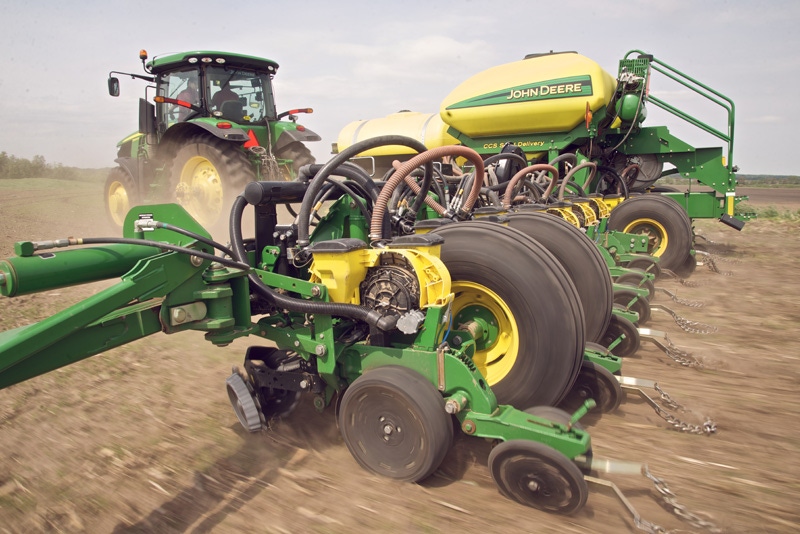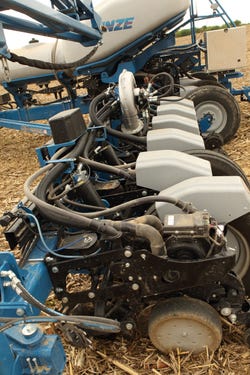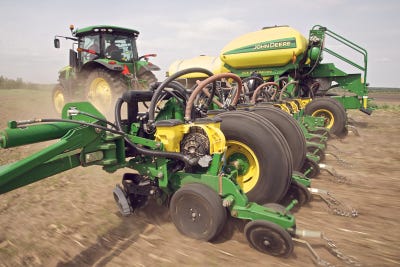August 27, 2014

Following announcements of multi-hybrid concept planters by Kinze and Precision Planting last winter, both companies took many planters to the field this spring to prove that the concept machines work as theorized.
Officials from both companies say multiple planters used on thousands of acres across the Corn Belt proved their planting technologies perform well in the field.
Now, as they wait for yield data, the companies are finalizing commercialization plans.
“The planters have performed extremely well,” says Rhett Schildroth, senior product manager for Kinze Manufacturing. “Based on the positive spring, we have decided to put the multi-hybrid planter into production. We will have it available on a limited basis for 2015 planting.”
At Monsanto-owned Precision Planting, Dale Koch, multi-hybrid product manager, says growers should look for an announcement about 2015 multi-hybrid planter availability at the Farm Progress Show, Aug. 26-28 in Boone, IA. “We really had a fantastic spring,” he says. “We put in thousands of acres with the multi-hybrid system and it did what we asked it to do, giving us the ability to plant each hybrid and each row at any population.”
Grower interest in multi-hybrid planters has been strong, says Koch. “Customers have been asking us about this technology for years,” he says. “There is just a lot of pent-up demand.”
“Conceptually, farmers understand the potential benefit of planting multiple hybrids in the same field,” adds Schildroth. “They want to know when they can buy this.”
Kinze six-planter test

Removing the row unit cowling on this Kinze 4900 Series multi-hybrid planter highlights extra seed and vacuum plumbing and the layout of dual seed meters. Photo courtesy Burrus Hybrids
Kinze built six multi-hybrid planters for 2014 field testing. It enlisted four seed companies to run five of the planters over thousands of acres across their territories, in addition to its own field trials. Seed company partners included AgriGold, Beck’s Hybrids, Burrus Hybrids and DuPont Pioneer.
“For this concept to take off, the seed companies need to be engaged to support the practice,” says Schildroth.
Burrus Hybrids, for example, used a 16-row Kinze multi-hybrid planter to seed 1,400 acres of corn on 22 farms stretching from southern Wisconsin to southern Illinois and western Missouri. To compare multi-hybrid planting with current practices, the company planted alternating strips with offensive and defensive hybrids, interspersed with strips with the two hybrids placed by productivity zones within the strip, says Tom Burrus, company president.
“We agreed to take on this work because we wanted to see the data the way we like to do it,” says Burrus. “The question comes down to is there enough yield difference to pay for the planter, pay for the technology needed to choose hybrids for productivity zones and give a higher return to the grower. That’s what we will find out.”
The Kinze multi-hybrid planter is based on the company’s 4900 Series planter, which was introduced for 2014. The multi-hybrid version of the planter uses dual electric drives for each row. They power twin 4000-Series vacuum seed meters placed side by side atop each row unit. Seed is delivered from each meter through a Y-transition to a single seed tube. The planter is plumbed to deliver separate hybrids from the planter’s standard two bulk seed tanks.
Electronics to control the multi-hybrid planter were developed by Raven Industries, using the Envizio Pro XL platform. Raven is continuing development work on the interface with yield monitors to accurately capture yields of separate hybrids across the field, says Douglas Prairie, Raven product manager.
Although Kinze has not announced 2015 pricing for its multi-hybrid planter, Schildroth estimates that payback for adding multi-hybrid capabilities to a new 4900 planter will be quick. “Assuming this increases the cost of a planter by approximately $30,000, you could pay for the cost of this technology in about a year,” he says. That assumes a 6 bushel/acre yield increase over 1,000 acres with corn at $5/bushel. For information, visit kinze.com.
Precision Planting roll-out

Precision Planting field tested multiple John Deere and Kinze ASD multi-hybrid planters. The planters were modified with dual V-Set metering systems, two electric drives for each row and extra plumbing from bulk seed tanks to route hybrids to dual seed meters. Photo courtesy Precision Planting
The Precision Planting multi-hybrid system, which includes a pair of the company’s V-Set meters in a unified housing for each row, is designed to be retrofitted to a range of planter models and brands. For 2014 testing, the company outfitted an undisclosed number of John Deere Central Commodity System and Kinze ASD planters, which planted thousands of acres across seven states, says Koch. Some of those tests were part of Monsanto’s FieldScripts program, which is designed to help farmers chose hybrids and planting populations based on productivity zones.
The dual V-Set metering system at the heart of the company’s multi-hybrid approach was designed to drop seed into the seed tube without intermediary plumbing. To accomplish that, the meters face each other, with seed plates revolving in opposite directions. Seeds drop from the meters in the same fore-aft position, with a seed trajectory that meets in the middle of the seed tube. “Having a common drop point gives us better assurance of accurate seed spacing,” says Koch.
Other key components of the system include two electric drives for each row, hoses to plumb bulk seed tanks to route hybrids to respective seed meters, plus a SeedSense monitoring system. The system can accept any multi-hybrid prescription in the common shape file format. For information, visit precisionplanting.com.
Multi-hybrid yield benefits
With thousands of acres of multi-hybrid trials in the field this year, the availability of data on the yield impact of planting offensive and defensive hybrids where they are best suited within a field will grow dramatically following the 2014 harvest.
But past field trials show substantial potential for yield increases with minimal extra expense besides a multi-hybrid planter, says Jason Webster of Beck’s Hybrids.
“In two years of trials, we have seen an average yield response of just under 10 bushels/acre and an average increase in net returns of $54/acre,” says Webster, who used a modified Kinze twin toolbar planter to plant trials in 2012 and 2013.
In 2013, South Dakota State University trials showed an average yield increase of 5.1 bushels/acre for multi-hybrid hybrid planting. The best combinations of hybrids in the trials showed about an 8 bushel/acre yield hike.
Webster says most farms would boost yields with multi-hybrid planting. “If your farm is black, flat and beautiful, with no soil type and topography changes, you probably won’t benefit from this,” he says. “But probably 75% of the marketplace has variability that could benefit from multi-hybrid planting.”
Assuming ongoing trials continue to document yield increases, Webster predicts rapid adoption of multi-hybrid planting systems. In the future, he expects yield benefits to increase as hybrids are refined for specific field environments.
Like what you’re reading? Subscribe to Farm Industry News Now e-newsletter to get the latest news and more straight to your inbox twice weekly.
About the Author(s)
You May Also Like






